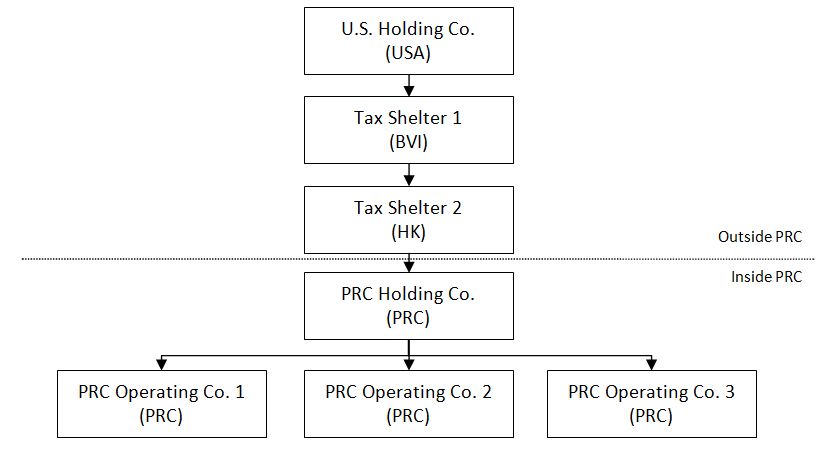This article is part of our Rising Star Portfolios series.
Last week, I wrote about the Dada Portfolio's decision to purchase shares of China Yida
With today's article, I want to transfer some of my comfort with Chinese investments to you. So let's start by taking a look at the holding structures of U.S.-listed Chinese companies. One of my responsibilities while I was an investment bank analyst in Beijing was to structure private equity deals so that a foreign investor could purchase Chinese assets. I never thought that particular skill would ever come in handy, yet, here we are.
Now that's what I call an org chart
While every company is going to be slightly different, all U.S.-listed Chinese companies have a corporate holding structure that follows a similar pattern (please note that "PRC" refers to People's Republic of China and is my preferred way of referring to mainland China):

The arrows indicate direct ownership and they flow downward, meaning that the company at the top of this chart ("U.S. Holding Co.") has equity ownership in all of the companies below it. However, keep in mind that income and cash actually flow upwards.
The "U.S. Holding Co." is a shell company with no actual operations. This is the entity that has its shares listed on a U.S. exchange like the NYSE or Nasdaq. If you are a Baidu
Despite not having any operations, the value of the "U.S. Holding Co." (and thus, the value of the shares that you own) comes from the entity's ownership of the "PRC Operating Companies" and the operating results they obtain. For the most part, the distinction is moot, and most people treat it that way. When someone talks about Sohu.com
How to save on taxes, Chinese-style
The "Tax Shelters" are intermediary holding entities that provide some sort of tax benefit to the company. The Cayman Islands, British Virgin Islands (BVI), or Bermuda are common tax havens that reduce the amount the U.S. government can levy on a company. "Tax Shelter 2" is often located in Hong Kong, which imposes no taxes on any dividends received from Chinese companies. One might say that this is needlessly complex, but a quick look at your average U.S.-listed Chinese company's effective tax rate shows that the effort often pays off:
|
Company |
Effective Tax Rate in 2009 |
|---|---|
|
Average U.S. corporate tax rate |
35.0% |
|
China Yida |
25.9% |
|
Baidu |
11.8% |
|
Ctrip.com |
16.5% |
|
Sohu.com |
16.1% |
|
China Green Agriculture |
13.9% |
|
Shanda Interactive |
22.0% |
It is only past these layers of tax shelters do we finally find a domestic PRC company. Depending on the ownership structure, the PRC holding company and its operating subsidiaries may either be WFOEs or JVs. WFOE stands for wholly foreign-owned enterprise, but if you're ever in China you'll hear it pronounced "wolfie" because it can also be abbreviated as WOFE, for wholly owned foreign enterprise (don't ask me about how Chinese people come up with English names -- I used to work with a vice president-level woman in her mid-30s named Ice, and the head of our finance team was named Mantic). What JV stands for is a bit more obvious: joint venture. But be aware, the "JV" title suggests more than just collaborative effort; it's an official legal designation governed by different rules and regulations than a WFOE or a wholly Chinese corporate entity.
Since most U.S.-listed Chinese companies have a "PRC Holding Co." analogue that is 100% owned by a "Tax Shelter" analogue, the majority of these onshore (inside the PRC) operating/holding companies are WFOEs. Even if a company does have a joint venture partner, typically the joint venture entities are established offshore (outside of the PRC) to avoid further PRC regulatory hassle.
The irony of the WFOE is that from our perspective as non-PRC residents and investors, we think of Baidu, Yida, Ctrip, and so on as "Chinese" companies. But from the Chinese government's perspective, they're actually foreign companies that happen to have operations in China -- no different from McDonald's or Microsoft. This is super important! One must keep this subtle distinction in mind as it has the potential for serious ramifications for outside investors in these companies.
And next time ... the dangers
We've seen how this holding structure can be a significant boon, but there are some very real negative implications as well that not many investors are aware of, ones that could make you completely rethink any investment in a U.S.-listed Chinese company. In my next article for the Dada Portfolio, I plan on discussing and exploring these risks. In the meantime, check out our Foolsaurus page here and follow us on Twitter @TMFDada!
The Dada Portfolio is a part of the Rising Star series of real money portfolios. It is co-managed by Sean Sun and Ilan Moscovitz. If you're interested in learning more about the portfolio, click hereto join us on our discussion board.



